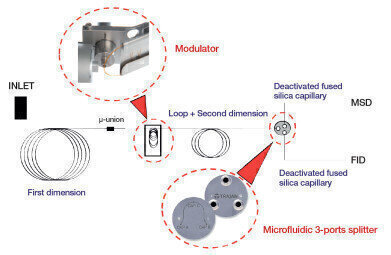GC-MS
GCxGC with parallel MS and FID detection for improved analysis of fragrances
Sep 24 2019
Gas chromatography Mass Spectrometry (GC-MS) is broadly employed for the analysis of allergens and aroma compounds in fragrances. However, the analytical challenge is not trivial. The complexity of essential oils and perfumes typically requires multiple analyses with different stationary phases to achieve suitable resolution for all targets.
Comprehensive two-dimensional gas chromatography (GC×GC) couples two columns in a single analysis to achieve superior separation power. Peaks are distributed across a 2D separation space based on different physicochemical properties, enhancing resolution and significantly reducing co-elution. These advantages make GC×GC-MS increasingly more widespread in the fragrance industry for accurate and time-effective targeted analysis as well as untargeted profiling.
In this application note Dr. Daniela Peroni demonstrates the feasibility of thermally-modulated GC×GC with parallel MS/FID detection to combine enhanced identification capability and robust, reliable quantification in fragrance analysis.
Experimental
Instrument: 7890B GC equipped with FID and 5975C MSD with Triple-Axis detector (Agilent).
Modulator: Cryogen-free loop-type thermal modulator (ZOEX) with Optimode module (SRA Instruments).
Software: MassHunter for acquisition, GC Image for data visualization and processing.
Set-up: Outlet flow split to MSD/FID with a microfluidic 3-ports splitter (Trajan) and uncoated capillaries.
Results and discussion
In this configuration with parallel detection (Fig. 1) the choice of the correct splitter is of the upmost importance. Since GC×GC peaks are very sharp, band broadening and tailing should be minimised to preserve resolution. With this is mind, we selected a low-dead-volume planar microfluidic device. The performance of this set-up is assessed with a mixture of linear alkanes. Peak shape in terms of width and symmetry is satisfactory for both signals (Fig. 2). In this work we use identical capillaries to connect the splitter to the detectors, if needed the MSD/FID ratio can be adjusted by using restrictions with different, appropriate dimensions. This is useful, for instance, to increase sensitivity at the FID.
If you want to know more about this application note please contact one of our experts or read the full application note here.
Digital Edition
Chromatography Today - Buyers' Guide 2022
October 2023
In This Edition Modern & Practical Applications - Accelerating ADC Development with Mass Spectrometry - Implementing High-Resolution Ion Mobility into Peptide Mapping Workflows Chromatogr...
View all digital editions
Events
ACS National Meeting - Fall 2024
Aug 18 2024 Denver, CO, USA
Sep 04 2024 Chiba, Tokyo, Japan
Sep 04 2024 University of Warwick, Coventry, UK
Sep 10 2024 Rockville, MD, USA
Plastics Recycling World Expo Europe
Sep 11 2024 Brussels, Belgium

-or-3D-view-(middle)..jpg)
-with-GCxGC-MSD-FID.jpg)













